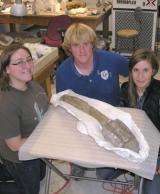Students' sharp eyes restore dinosaur's rightful name

(PhysOrg.com) -- Three graduate students in paleontology blew dust off dinosaur toes found in 1924 to discover that something didn't quite add up. After examining a few more fossilized bones, they concluded that a 1970s reclassification of the dinosaur's species was wrong, and that the original paleontologist had it right the first time around.
PhD candidate Victoria Arbour was one of three University of Alberta students studying a 76 million-year-old anklyosaur, an armadillo-like dinosaur about four metres long. It was found in 1924 in southern Alberta by the late Canadian paleontologist William Parks.
"From a partial set of fossilized bones, Parks concluded that it was a new species of anklyosaur that he named Dyoplosaurus, or double-armoured dinosaur," said Arbour. "But in the 1970s a new set of researchers came along and reclassified Park's find as another anklyosaur species called Euoplocephalus."
Arbour and fellow students Mike Burns and Robin Sissons weren't thinking about the reclassification issue when they went to the Royal Ontario Museum in Toronto for a close look at Parks' discovery.
"We were all interested in anklyosaurs, but we were all focused on different parts of the skeleton," said Burns, who examined the dinosaur's body armour and skull. Arbour focused on the animal's pelvis and clubbed tail. Sissons was interested in how the animal got around and looked closely at its foot and limb mechanics.
"There was something different about the toes on this specimen," said Sissions. "It didn't match the structure of the dinosaur species it had been reassigned to by the 1970s researchers."
That's when the grad students began questioning the reclassification. "I found the pelvis didn't match up with what we know about Euoplocephalus," said Arbour. When Burns found the texture of the dinosaur's armoured plates also differed from the Euoplocephalus, the students realized they were all finding inconsistencies with the reclassification.
Still, they needed to compare their findings with one more dinosaur collection, just to make sure. "I went to the American Museum of Natural History in New York and examined their anklyosaur collection," said Arbour. "I found the same small differences that confirmed for us Parks had identified his dinosaur correctly as Dyoplosaurus."
Despite the trio's success, there was no uncorking of champagne. "The Eureka moment passed quietly," said Arbour. "The 1970s researchers didn't think Parks' find was different enough from other anklyosaur finds to warrant classification as a separate species."
The students say Parks was justified in branding his anklyosaur find as the species
Dyoplosaurus, and their findings were published this month in the Journal of Vertebrate Paleontology.
Provided by University of Alberta

















